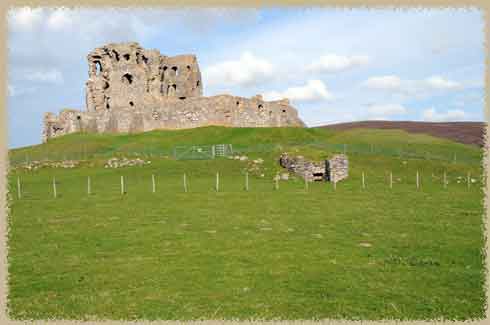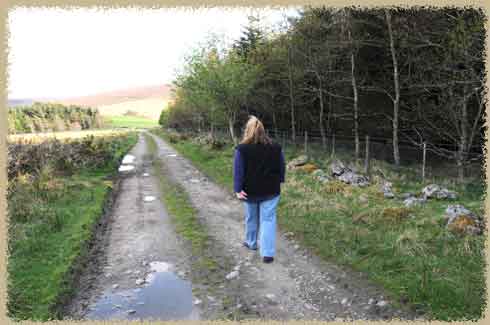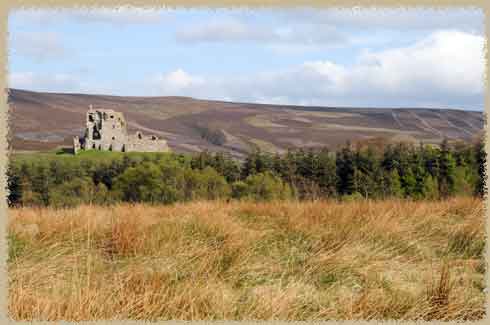Auchindoun Castle
I had thought some of our other forays had been windy, but today was a whole new level of W-I-N-D-Y. The news reported 80+ mph gusts, and I'm quite sure that we were in a few of them.Uitwaiian, indeed.Walking in windy weather for fun! There were a couple of times it was hard to talk, the wind howled so loudly.
 thw tower and wall of the castle, on the site of an iron age fort
thw tower and wall of the castle, on the site of an iron age fort
Adventure Girl definitely showed up for this castle -- the trek up the hill and through the pastureland can be steep and muddy. Head up the narrow road that is signposted, and at the top, turn left and walk around the field and through an abandoned farm. Avoid the sheep. The castle has only recently reopened for visits, after much work by Historic Scotland to stabilize the ruins enough to allow safe viewing.

Adventure Girl hikes into the fields, knowing there's a castle up there somewhere
We were just glad that enough of the walls remained to give us a quiet place to stand for a few moments.
Iron Age roots
The massive hill here, rising above the forest, was the site of an Iron Age hill fort -- probably Pictish -- defensible, miles of visibility; no wonder it has been the site of fortifications ever since.
A stone caste was bult here for the Earl of Mar in the 15th century. When he was murdered by his brother (King James III), the lands went to Thomas Cochrane, one of the king's favorites. Jealous nobles hung him in 1482 and the castle passed to the Clan Ogilvy in 1489, and castle was associated with the Gordons by 1535, but was reclaimeed by the Ogilvy's in 1594 after the castle was destroyed by the Clan MacKintosh a few years earlier. Eventually, it was given to the Marquis of Huntly. (Seriously, these things change hands like a beach-rental in Fort Lauderdale.Ok, not fair, they do it over centuries, I suppose).

the 15th century keep
The castle was abandoned by 1725, and was subsequently usd as a quarry for local builders, and some of the stones may have been used building Balvenie Castle nearby. This is the fate of many of the stone castles in Scotland - they are an easy source of building materials, and until "state care" was started, they were fair game for anyone who wanted to demolish them.
Only about half the tower still stands, and you can see the thicknes of the walls on the "broken ends". There was a deep hole underneath the vaulted cellar, with railings. We peered down, but coudln't get any further. The floor of the main hall, with the high arched roofline, can be viewed, but the upper reaches of the castle are not accessible. We poked around a bit in the vaults and walked around the exterior wall (there is a sheer drop-off on the back side).

a first glimpse of the castle from the path
Medieval buildings
The bulk of the remaining castle was built during the ownership of Thomas Cochrane in the 15th century (he was a mason), with a large addition added in the 16th century by the Gordons. The central tower was massive, and surrounding by a tall curtain wall, most of which still stands. Cellars were dug into the bedrock of the hill, with vaults in the tower providing storage and kitchen areas. Inside the curtain wall, a range of other buildings have been discovered -- brewery, bakery, kitchens.
The main tower is in poor shape, and there is no access to the upper floors which would have included the hall and living quarters above.


